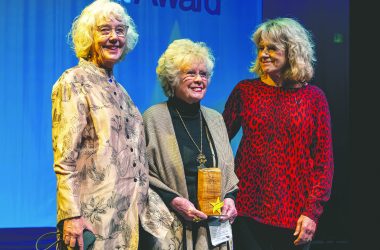 Horvath was recognized by his peers for bringing passion, expertise and commitment to the industry with the Curtis Pitts Memorial Award.
Horvath was recognized by his peers for bringing passion, expertise and commitment to the industry with the Curtis Pitts Memorial Award.
Tony Horvath’s award-winning career flying and building aerobatic airplanes all started with a fan letter he wrote as a young boy.
Only 8 years old at the time, Horvath, now 39, remembers seeing a local airshow pilot practicing aerobatics from his backyard. Horvath wrote to the pilot, and expressed his interest in the craft. The pilot wrote him back, setting in motion a lifelong flight plan. Steve Wolf, a longtime Creswell resident and pilot, invited the young Horvath to visit him at the airport and check out his projects.
“He’d be out there doing all the stunts right above our house, I thought that was just so cool,” Horvath said.
Horvath accepted the invitation, and said he hung out with Wolf for an hour. He first took flight as a licensed pilot on his 16th birthday in Cottage Grove, the earliest solo flights are allowed. Horvath said he was licensed to fly an airplane before he was licensed to drive a car.
 Horvath flies a plane he rebuilt for a customer over Coburg Hills.
Horvath flies a plane he rebuilt for a customer over Coburg Hills.
“I never knew it was my calling,” he said, “but any time I’ve tried to get away from it, I just get steered right back here. So what do you do?
“I wouldn’t know how to do anything else.”
His peers rewarded that passion and expertise, recognizing Horvath with the prestigious Curtis Pitts Memorial Trophy in August. The honor is the highest award given in the aerobatics community for non-flying.
The trophy was created in memory of Curtis Pitts, who designed the popular 1940s Pitt Special biplane, Horvath’s specialty. He has four of them in his shop.
Horvath said Pitts was known for being able to design an airplane that weighed the least but had the biggest engine possible. The award began in 2009, and is presented to an individual who has “done something for aerobatics to further aerobatics,” Horvath said.
“The majority of aerobatic hours are flown using these 1940s design Pitt Specials,” he said. “We’ve taken that airplane and just stretched it to the limit without calling it something else.”
To contribute to the advancement of aerobatics, Horvath has created a special line of products dedicated to enhancing the functionality of already existing airplanes. He said those kit products are designed to keep the Pitt Special a relevant aerobatic airplane for a long time.
“This has been my contribution for the people who do want to go out and do aerobatics and build a better airplane, create something different. So that’s what I’ve done.”
Horvath has worked with a variety of different clients from all over the world to help them achieve their airplane dreams.
“I’m kind of the guy they come to and say, I’ve got this idea, and we just gotta figure out how to make it happen. I figure out how to make this stuff happen.”
He said the hardest part of the job is educating the customer with what’s realistic for their airplane, but no request seems to intimidate Horvath. One client approached him with a request for a roadable airplane, in case he should be flying and encounter some bad weather.
 The “roadable” airplane in Horvath’s driveway in 2012. He and a friend drove the plane from Florida to Washington, never getting it off the ground.
The “roadable” airplane in Horvath’s driveway in 2012. He and a friend drove the plane from Florida to Washington, never getting it off the ground.
“It is what it sounds like,” Horvath said. “We took an airplane and then modified it in ways to make it able to drive on the road. The idea was that the guy would get stuck, turn this thing into a transformer and start driving down the road.”
Horvath and the client drove the airplane across the country, unable to catch a break from bad weather all the way from Florida to Washington.
“It was a ton of fun,” Horvath said. “We got pulled over in like 16 states.”
The ability to create a client’s wildest airplane dream didn’t happen overnight. Horvath said he worked on his first airplane for six years, from high school through college. After eight hours of flying his creation for the first time, he crashed it.
“The reason it crashed was because I had a part on there that wasn’t mission specific for that kind of airplane,” Horvath said. “The field I went into had three feet tall grass. As soon as I touched the top of the grass it just ate the airplane and flipped it over. Smashed the fan off, but I got out okay.”
Horvath said he had seen someone driving past, and he hiked up to the driver’s house and asked to use their phone. The man asked if Horvath had crashed his car, and Horvath said, “No, my airplane.”
“You could see some stuff sticking up out of the tall grass. I had a big ol’ goose egg on my head because my head went through the windshield.”
Despite his experiences with past accidents, Horvath remains fearless. He said his favorite aerobatic maneuver is called the Hammerhead, also known as a stall turn. According to the Merriam-Webster dictionary, during a Hammerhead maneuver the pilot flies the airplane straight up until the airspeed drops to a critical point, then drops the nose towards the ground and falls.
“In this line of career we’ve had a lot of friends who didn’t make it,” Horvath said.
After graduating college and being laid off from a prior company, Hovarth’s business, Specialty Aero, was kick-started by a simple sign. He said everything had just collapsed in 2009, and he was trying to decide what to do next.
“Do I go work for someone else, what do I do? And this connection that I made, his name is Sean Tucker. He’s the best airshow aerobatic in the United States.”
Sean Tucker is sponsored by Oracle, and Horvath built Tucker’s current airshow airplane: The Oracle Challenger 3. Horvath said Tucker retired in 2019, and The Oracle Challenger 3 is also retiring next year in the Smithsonian.
“He flew it for 10 years. And 10 years, the way he flies, is plenty on an airplane.”
 Horvath and his daughter pose in front of the plane he built for a customer in Germany. His daughter’s pedal plane is in front.
Horvath and his daughter pose in front of the plane he built for a customer in Germany. His daughter’s pedal plane is in front.
Old airplanes are retiring and new ones are being created. Starting in December, Specialty Aero’s upcoming project is a Hall Bulldog 1930s style racer replica airplane for a customer in Corvallis.
The Hall Bulldog wasn’t a successful racing airplane and it was only around for 8 weeks during The Great Depression era, but Horvath said this customer of his is a huge fan of the airplane, thinks it’s the coolest looking airplane and wants to recreate it. Horvath describes it as a “totally wild looking, teeny tiny distinctive racing airplane.”
“The stars have aligned and we’re going to do it again and build this airplane. That’s the next two years of Specialty Aero’s life.”








